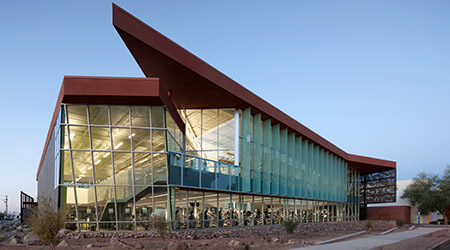 The 108,000-square-foot Student Recreation Center, a LEED Platinum facility, uses PVs to heat its pool and provide energy for cooling. University of Arizona
The 108,000-square-foot Student Recreation Center, a LEED Platinum facility, uses PVs to heat its pool and provide energy for cooling. University of ArizonaReal-Time Energy Monitoring Avoids Peak Demand Charges, Helps Bill Accurately
Beyond the benefit of simply saving energy, active energy management ensures accuracy in billing and a lower overall cost of energy.
While fault detection helps avoid problems, another function of the university’s real-time monitoring system helps avoid cost. By monitoring use at each piece of equipment, but most notably at chiller plants in the white hot desert summer, Kopach and his team are able to avoid peak demand charges.
“When we’re operating chiller plants at the magnitude we are, we need real-time data, information, and fault detection to make decisions about when to start the next chillers,” says Mark St. Onge, assistant director of utilities in the facilities management department. “Avoiding the peak is critical.”
Kopach says he’s worked closely with a consultant to develop analytics that, based on each chiller’s load and efficiency, allow operational changes to be made in real-time. “Our active monitoring system gives us the ability to keep under the red line, which saves us hundreds of thousands of dollars,” say Kopach. “It gives us the key pieces of information we need to have to make decisions in real-time.”
Perhaps the one place the active energy management system is most beneficial for the campus at large is in how it has improved the ability to bill accurately. In the past, there was more than a little estimating, says Kopach. And even in the cases of buildings with installed meters — many campus meters were put in place in 2008, years before the active monitoring system was as sophisticated as it is now — the data weren’t accurate or usable. The campus includes a large medical complex with a major trauma center, which is privately owned, so inaccuracies in billing were more than just a problem for the university.
“When I came here in 2010, we had 800 meters, but on a lot of them we were seeing zeroes,” says Kopach. “Something wasn’t right. We had to estimate a lot of the meter reading. So there were serious concerns about accuracy and the data not being processed correctly.”
Remedying this problem was a two-step process. First, it involved building out the analytics, monitoring, and fault detection to ensure that the data being analyzed and monitored was accurate. And secondly, Kopach and his team added an electronic billing system, which is tied to the overall active monitoring system. (The billing group is the third musketeer of Kopach’s metering team, along with IT, which Williams runs, and utilities, which is St. Onge’s charge.) Billing is now automatic and precise, says Kopach. “With this new computerized system, we know we are billing accurately.”
Related Topics:















